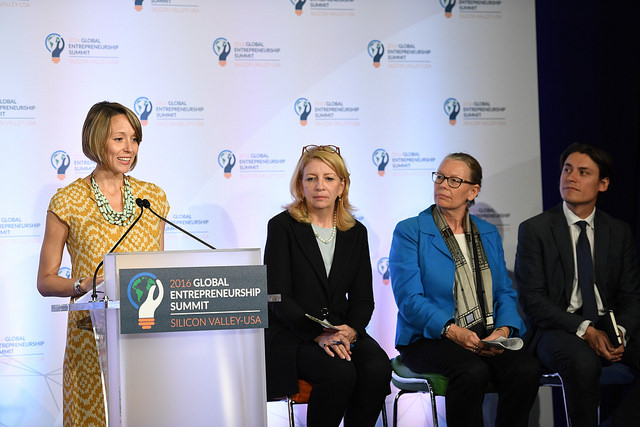Weekly Roundup is a McNair Center series compiling and summarizing the week’s most important Entrepreneurship and Innovation news.
Here is what you need to know about entrepreneurship this week:
The Carried Interest Debate
Tay Jacobe and Jake Silberman, Research Assistants, McNair Center for Entrepreneurship and Innovation
McNair’s Jacobe and Silberman analyze the ongoing discussion surrounding carried interest. A complicated concept in the financial sector, carried interest refers to the profits earned on a private investment fund that are paid to fund managers. Private investment funds include VC, PE and hedge funds.
Debate arises from carried interest’s subjection to the capital gains tax rate. The capital gains tax rate caps taxes on carried interest at 20 percent. Critics of the so-called carried interest “loophole” argue that the government should tax carried interest at the standard federal income tax rate of 39.6 percent. Supporters of maintaining the capital gains tax rate for carried interest claim that it acts as a performance incentive for fund managers.
During the 2016 presidential campaign, Trump criticized the massive profits that investment fund managers earned from carried interest. Since taking office, President Trump has not commented on his administration’s plans for taxation on carried interest. The House Republican’s 2016 Tax Reform Proposal proposes a “reduced but progressive” capital gains tax on carried interest. As Jacobe and Silberman note, such a plan would likely cause fund managers’ net incomes to go up.
Looking Forward: Why the VC Industry Needs More Female Investors
Dana Olsen, Reporter, PitchBook
PitchBook’s Olsen analyzes the need for promoting gender diversity in VC firms. Despite modest gains in diversification at many VC firms, most firms are yet to make substantial change. In 2016, only 17 percent of global VC deals involved companies with female founders, while only 9 percent were female-led at the time of backing. Admittedly, these statistics reveal improvements from 2007, when these numbers stood at 7 and 6.8 percent, respectively.
According to Olsen, “the most efficient way to increase the number of female-founded companies that receive VC funding is to have more female venture capitalists.” Aileen Lee, prominent venture capitalist and founder of Cowboy Ventures, believes that “women who have more numbers on the investment team invest in more women.” Another obvious way to increase rates of female entrepreneurship is to introduce educational programs that spark girls’ interest in STEM-related fields at an early age.
A Dearth of I.P.O.s, but It’s Not the Fault of Red Tape
Steven Davidoff Solomon, Contributor, The New York Times
University of California, Berkeley School of Law’s Professor Davidoff Solomon writes for the New York Times on the recent decline in IPOs in the U.S. Many politicians point to over-regulation of the private market as an explanation, evidenced by the line of interrogation at the confirmation hearing of President Trump’s nominee to head the SEC, Jay Clayton. Since 1996, the number of publicly listed firms on the NYSE has been cut by nearly half. Furthermore, the number of IPOs has decreased from 706 in 1996 to only 105 in 2016.
Professor Davidoff Solomon proposes a number of theories for explaining the dropoff in deal-making activity – none of which involve government regulation. Firstly, Davidoff Solomon suggests that “structural changes in the market ecosystem” might be encouraging increased mergers and acquisitions in public and private markets, respectively. Alternatively, the dropoff in IPOs could potentially be caused by a decline in attractiveness of small offerings as the public. In 1996, 54 percent of new offerings were considered large, compared to only 4 percent in 2016. According to Davidoff Solomon, the “market for new issues has moved toward liquidity and bigger stocks.”
And in the Startup News…
New Clerky Tools Help Startups Hire and Raise Funds without Running into Legal Problems
Lora Kolodny, Contributor, TechCrunch
Founded in 2011, Clerky is a San Francisco-based startup that builds software to assist startups and their attorneys with legal paperwork. The startup, founded by former attorneys, focuses almost exclusively on providing legal templates and software for high-growth startups. Originally, Clerky’s services centered around helping startups incorporate their company online. Now, Clerky is looking to expand its services beyond business formation, with its latest two online tools Hiring and Fundraising.
By using Clerky, startups can spend their cash on higher level services and advice, rather than costly legal paperwork. For example, many startups spend thousands of dollars on attorney’s fees for handling seed rounds finances. With Clerky, however, companies can pay $99 in return for six months of unlimited issuances of SAFEs and convertible notes. Many of Y Combinator’s co-founders have used Clerky’s Formation tool to launch their business. Now, they can also rely on the firm’s software throughout their various growth stages and funding rounds.
Dropbox Secures $600M Credit Line with IPO on Horizon
PitchBook News & Analysis
Last week, the Weekly Roundup series covered a PitchBook article on a relatively recent trend in startup financing: debt. Debt financing is not uncommon for startups that are looking to go public. IPO are costly, and opening up lines of credit gives a company some cash without “diluting equity stakeholders.” However, many startups without IPOs in their near future are increasingly accumulating debt; according to PitchBook News and Analysis, funding rounds that were at least partially debt brought in $14 billion in deal value in 2016.
Dropbox, the latest tech unicorn to announce debt financing ahead of an upcoming IPO, is a well-known startup that provides users with cloud-based storage services. Dropbox reportedly secured the $600 million line of credit ahead of a possible offering in 2017.
With Mulesoft’s successful IPO in March, 2017 could deliver a good year for tech enterprise. Cloud-based identity management firm Otka is another enterprise tech firm set to go public within a few weeks.




 CincyTech
CincyTech





